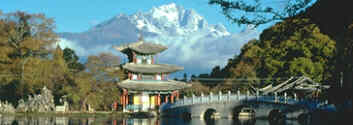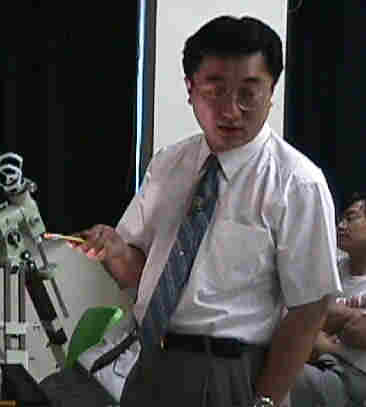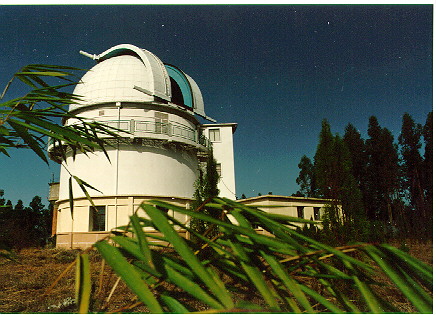

Dr. Kaifan Ji is the chief astronomer at the Yunnan Astronomy Observatory in Kunming, China. In 1993, Dr. Ji received his Ph.D. in Astronomy from the Chinese Academy of Sciences. His graduate study was at the Yunnan Observatory, but he completed his undergraduate degree in Astronomy at Beijing Normal University in 1988. The accompanying picture of Dr. Ji was taken as he presented a report to students at the the Ho Koon Nature and Astronomical Centre, a facility funded by Sik Sik Yuen, a prominent Taoist organization in Hong Kong. Dr. Ji was asked to visit the facility and help them calibrate the CCD for their 20-inch telescope, and provide assistance with their computer systems used in teaching astronomy. We have another picture of Dr. Ji, when he was about age 26, at the time he received his doctoral degree, along with pictures of his family and other colleagues.

Professor Bin-Xun Ye is a solar physicist at the Beijing Astronomical Observatory. He completed his advanced studies in the early part of the Cultural Revolution, when there was no Doctoral Degree program in China. He is recognized worldwide as a scholar who is equivalent to a Doctor of Philosopy (Ph.D.)in Astronomy. Professor Ye chaired the Chinese Research Laboratories for Astronomy for nearly two decades. He has done extensive work with instrumentation, specifically at the Yunnan Observatory, where he worked from 1972, helping to build it up from its early stages. His current primary interest is in techniques for observing astronomical objects with widely varied brightness. This is why the RPO project has used pictures of Mars and its satellites and binary stars as the primary objects of study. He first discussed the ideas that led to development of the RPO Project when he had an opportunity to be at the Kitt Peak (Tucson, AZ, USA) McMath-Pierce Solar Tower for some experiments, while at the same time he had telescope time scheduled at Kunming to perform SRT experiments on Mars and its satellites. At that particular time, an e:mail transmission between China and the USA could take hours, due to problems with telephone connections. Professor Ye said, "If the Chatnet connection had been available at that time, I could have managed the observations from both telescopes from my notebook computer, while sitting on the Saguaro mountain peaks."

Professor Yi Chu normally works as an Associate Professor of Astronomy at Nanjing University, in Nanjing, China. Nanjing is located inland to the west of Shanghai. At the time of the RPO experiment in March, 1997, he was serving as visiting professor of astronomy at the University of Florida, at Gainesville. The RPO experiment made use of Professor Chu's assigned time at the Kunming telescope, and he was able to direct the onsite team in capturing images for his further study, using the SRT image differentiation techniques to obtain images of both Mars and its less bright satellites. The accompanying picture shows Dr. Chu looking at one of the images on his computer screen in Florida, with University of Florida astronomer, Dr. Kwan-Yu Chen looking on. Professor Chen is the principal investigator of the University of Florida astronomy research group, with whom Professor Chu is working in his current assignment. This photograph is used by permission from the Gainesville, Florida Sun , where it appeared with their story on Professor Chu. [The Sun has granted permission to use this photograph ONLY on this hompage, for this use only. It was taken by John Moran, The Gainesville Sun (c) 1997

The telescope, pictured above, through which the observations were made was constructed in East Germany, and installed in the Yunnan Observatory in March, 1979. Until 1988, this 1-meter mirror telescope was the largest in China; at present it is the fifth largest in China. The team at this observatory is presently working on plans to construct a much larger telescope at a higher elevation. The optics and the mirror for the new observatory will be constructed entirely in China, which will be a major world-class accomplishment.
Other members of the team at the observatory, carrying out the numerous tasks required to aim the telescope, operate the computers, perform calculations needed to obtain properly exposed images, are: Dr. Qian Song, Dr. Wenda Cao, Dr. Qingyu Peng, and Mr. Veivei Liu. [Those familiar with Chinese names will realize, we have employed western usage, with given name first, surname last; whereas proper usage in China lists surname first, followed by given name(s).]
Professor Ye built the first device in China for taking electronic pictures through an observatory telescope. Astronomers refer to these devices as a CCD, which means "Charge Couple Device." In lay terms, it is much like a video camera, but has sharper optics and all the electronic chips are kept at a very low temperature (minus 120 degrees Centigrade!) in a specially constructed thermal bottle. Images are captured using Flexible Image Type S (FITS) coding, which is the standard in Observatories throughout the world. To send the images over the internet, these highly detailed images are compressed in standard JPEG format (.jpg).

Go back to the top of this document, OR return to the RPO index page to see the credits and thank-you messages